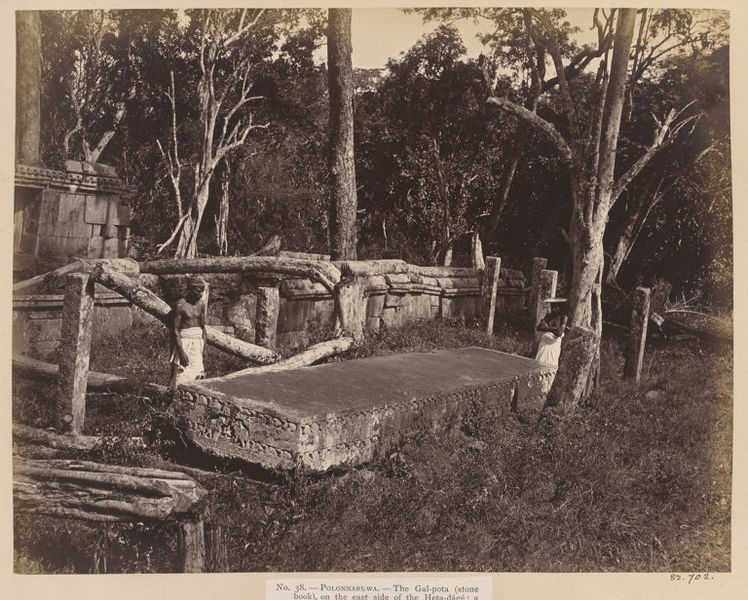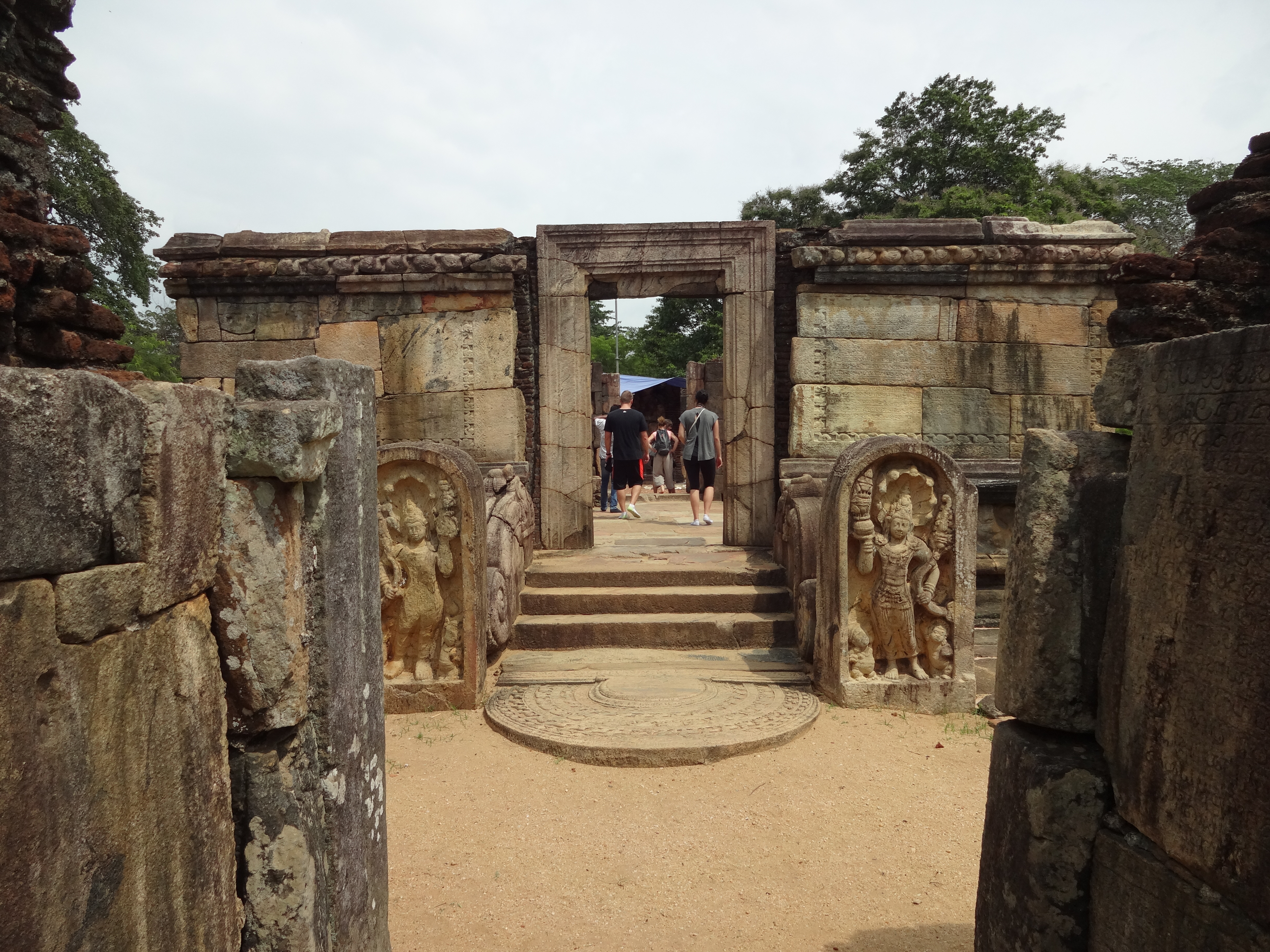OB03062 Poḷonnaruva Niśśaṅka-Dāna-Vinoda-Maṇḍapa Pillar Fragment
IN03082 Poḷonnaruva Niśśaṅka-Dāna-Vinoda-Maṇḍapa Inscription
The inscription is engraved on two sides of the upper portion of the shaft of a stone pillar. It was seen by Wickremasinghe in Archaeological Commissioner’s Office at Tōpaväva in Poḷonnaruva sometime before 1927, having been discovered by S. M. Burrows in 1885-6. The inscription consists of 12 lines and records that a pavilion called Niśśaṅka-dāna-maṇḍapa was constructed for the purpose of witnessing the great rejoicings of the beggars who had received alms from the king Niśśaṅka-Malla. It is therefore quite obvious that this inscription dates from the reign of Niśśaṅka-Malla (1187-1196 A.D.) and originally stood somewhere at the entrance to the Niśśaṅka-dāna-maṇḍapa. Burrows found the pillar-fragment in a ruined building, with massive pillars, abutting on the bund of Tōpa-väva tank in Poḷonnaruva and consequently identified this building as the Niśśaṅka-dāna-vinpoda-maṇḍapa (‘the pavilion for the past-time of Niśśaṅka-almsgiving’). This identification was confirmed in 1902 by H. C. P. Bell, whose excavations revealed that the building originally stood at the centre of quadrangular terraced platforms and had therefore been well suited for witnessing the distribution of alms.
OB03061 Poḷonnaruva Galpota (‘stone-book’)
Galpotha Inscription, Polonnaruwa.
Polonnaruwa. The Gal-pota (stone book), on the east side of the Heta-dágé; a single stone 28 feet long, 5 feet broad, and averaging 2 feet 5 inches in thickness, the upper face inscribed, and the sides and ends sculptured. Photographed by Joseph Lawton (d. 1872), active in Sri Lanka between 1866 and 1872. V&A 82702.
IN03081 Poḷonnaruva Galpota Slab Inscription
The inscription is engraved on an oblong slab, called gal-pota (‘stone-book’), which lies close to the eastern outer wall of the so-called Häṭa-dā-gē, ‘the Shrine of Sixty Relics’, at Poḷonnaruva. Consisting of seventy-two lines and more than 4,300 letters, the inscription is the longest known in Sri Lanka. It was created during the reign of Niśśanka Malla (1187-1196 A.D.) but no specific date is given in the text. The contents of the inscription record the great actions of Niśśanka Malla. Wickremasinghe interprets the text as part of an broader political strategy in which the king commissioned numerous inscriptions extolling his good deeds in a bid to present himself as a sovereign who held his authority entirely for the good of the community, thereby winning the confidence of his subjects and securing his claim to the throne. Niśśanka Malla appears to have been the first Sri Lankan monarch to employ such a strategy. The galpota inscription contains an important exposition of his political theory of kingship.
The galpota is aligned north-south and measures more than eight metres long. It was raised on a brick podium sheltered by a canopy supported on ten pillars. Both sides and ends of the slab are ornamented by double bands of haṁsas moving from left to right. At the middle of each end is a seated figure of Lakṣmī holding flowers, upon which a pair of elephants pour water from a chatty. The surface of the slab is divided into three partitions, each of which contains a portion of the inscription, starting from the first line at the top left-hand (south-west) corner of the stone slab. These partitions are designed to be read separately. The third partition is damaged, rendering some parts of the inscription illegible. A postscript on the vertical face of the southern end of the slab tells us that this stone was brought for the special purpose of engraving the present record from Sǟgiriya (Mihintale) by the mighty men of Niśśaṅka-Malla. This would imply that the slab was transported upwards of eighty miles. However, Wickremasinghe and others have suggested that the stone was in fact sourced from Sigiriya, only 15 miles distant, rather than Sǟgiriya.
OB03060 Poḷonnaruva Häṭa-dā-gē Inside Wall (fragments)
The Inner Shrine at the Hatadage, Polonnaruwa.
IN03080 Poḷonnaruva Häṭa-dā-gē Inside Wall Inscription
The inscription is engraved on a series of slabs originally built into an inside wall of the so-called Häṭa-dā-gē, ‘the Shrine of Sixty Relics’, at Poḷonnaruva. It was discovered by S. M. Burrows in 1885, along with another inscription in the vestibule of the shrine (IN03079) and one in the adjoining portico (IN03078). Consisting of eight lines, the inscription dates from the reign of Kīrti-Niśśaṅka-Malla (1187-1196 A.D.) and provides a tactfully worded exhortation to Buddhist monks to exercise care in the selection of persons for admission to the priesthood and to desist from doing things contrary to the teaching of the Buddha.
OB03059 Poḷonnaruva Häṭa-dā-gē Vestibule Wall
The Hatadage, Polonnaruwa. The vestibule wall inscription can be seen on the right in this photograph.
Detail of the vestibule wall-inscription at the Hatadage, Polonnaruwa.
IN03079 Poḷonnaruva Häṭa-dā-gē Vestibule Wall Inscription
The inscription is engraved on the front wall of the vestibule or pro-naos of the so-called Häṭa-dā-gē, ‘the Shrine of Sixty Relics’, at Poḷonnaruva. It was discovered by S. M. Burrows in 1885, along with another inscription inside the shrine (IN03080) and one in the adjoining portico (IN03078). The inscription dates from the reign of Kīrti-Niśśaṅka-Malla (1187-1196 A.D.), whom it refers to as Siṁhapureśvara Laṁk󠅛eśvara Kāliṅga-Cakravartī. The text consists of 17 lines engraved within a double border featuring a band of haṁsas (swans) and another of foliate ornament. It describes some of Niśśaṅka-Malla’s administrative and charitable acts.
OB03058 Poḷonnaruva Häṭa-dā-gē Portico Slabs
Entrance to the Hatadage, Polonnaruwa. The slab inscription can be seen on the right in this photograph.
IN03078 Poḷonnaruva Häṭa-dā-gē Portico Slab Inscription
The inscription is engraved on the portico of the so-called Häṭa-dā-gē, ‘the Shrine of Sixty Relics’, at Poḷonnaruva. It was discovered by S. M. Burrows in 1885; Burrows also discovered two further inscription in the shrine itself (IN03079 and IN03080). The inscription dates from the reign of Kīrti-Niśśaṅka-Malla (1187-1196 A.D.) and consists of 23 lines, starting with a Sanskrit stanza in triṣṭup śālinī metre and ending in a Sinhalese quatrain. Both of these stanzas contain Niśśaṅka-Malla’s appeal to future kings to protect and preserve the Dharma. The rest of the inscription describes some of Niśśaṅka-Malla’s administrative and charitable acts, including the building in stone of the Vaṭa-geya (‘Rotunda’), the (Niśśaṅka-latā-maṇḍapaya ‘Niśśaṅka flower-trail hall’), and the Niśśaṅka-daḷadā-geya (‘Niśśaṅka tooth-relic house’) at Poḷonnaruva.




